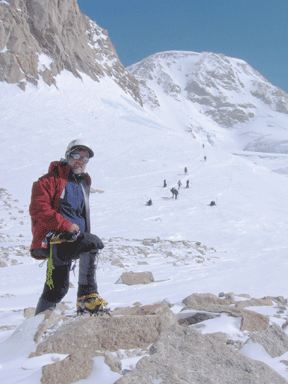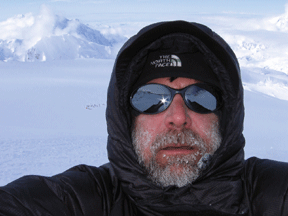Taking On The Great OneA local adventurer’s battle to climb Denaliby Kathy Reshetiloff
|
 |
Sarah, Don, Greg and Mathij celebrate their survival back at base camp. |
11,600 Feet
On May 15 the team reunites, reaching as high as 13,500 feet over four days on supply ventures and dropping back as low as 8,500 feet. Stymied by bad weather, they sleep at Camp 2 at 11,600 feet.
Each team creates and maintains its own camp. Bricks of ice are sawed and stacked into ice walls to protect the tents from collapsing in the fierce winds. The altitude takes its toll; simple tasks quickly tire them.
Even when sleeping, high-altitude climbers rarely rest deeply. Periodic breathing — Cheyne-Stokes respiration — becomes more frequent with increasing altitude. Deep breaths followed by very shallow breaths or even a pause in breathing can end with a gasp that wakes the climber. Many climbers awaken, gasping for air, all through the night.
“I didn’t feel the effects of altitude going from Base Camp to Camp 1,” Greg later reflected. “But climbing from Camp 1 to Camp 2, you start to experience it. Climbing is slower and more intense the higher you go. It’s quantitative.”
14,200 Feet — and Then There Are 5
Finally the weather breaks, and the seven anxious climbers move to Camp 3 at 14,200 feet. Again they climb up and down over several days, ferrying caches up and descending to sleep. Between Camp 3 and their next cache, they must climb an icy headwall, ascending 900 feet at a 45- to 50-degree angle. So they ditch their snowshoes for ice crampons.
Along the headwall, the Park Service has attached fixed lines onto which each climber must hook. One line is for ascension, another descension
On May 22, the final cache is buried at 16,000 feet. Coming down to Camp 3, Sandra reports headaches; her face seems swollen. Her symptoms worsen. It may be an allergy or acute mountain sickness, but the guides take no chances. She leaves with a descending party.
The next day, bad weather again seems likely to hold the team back. Just as the idea of a rest day settles in, a small weather window opens. Along with many other teams, they head for the fixed lines to High Camp.
But they are all sluggish and mentally unprepared, especially Amy. She stops frequently. About halfway to the fixed lines, she decides to retreat with a team descending to the 14,200 camp.
By the time the remaining team reaches the fixed lines, it’s a traffic jam. Many groups are waiting their turn. The risk of trying to keep warm while waiting is too great; they climb back down to 14,200 feet for the night.
There, Greg tries to persuade Amy to give the climb another night. “A good night’s rest and some food, and you will feel better in the morning,” he told her. “But she had made up her mind. She was done. So she left that afternoon.”
17,200 Feet — and Then There Are 4
On May 24, the team gets an early start, around 9am. With a headache, Tom stops frequently. As the team reaches the fixed lines at 15,000 feet, he’s not thinking clearly. Again they turn back, to take Tom down 500 feet to join a descending Alpine Ascent team.
The dwindling team climbs back to 15,000 feet, negotiates the fixed lines, picks up a cache and continues to High Camp at 17,200 feet. It’s 8pm after a long day. But no ice walls from previous camps are standing, so they have to build a wind wall. By 9:30pm, both tents are up.
“At 17,000 feet, I really felt the altitude and thin air,” Greg recalled after the climb. “Everything you do is exhausting. Putting on your gear, drinking water, moving your arms to keep the blood flowing, everything.”
After a bitterly cold and windy night, the last two climbers, Greg and Mathij, meet in the guides’ tent for breakfast. Mathij’s fingertips look like they have been dipped in wax. He has the beginnings of frostbite. He will have to take special care to protect them; refreezing risks amputation. They take a rest day. That night, the weather grows fiercer still. Despite the reinforced ice walls, Greg and Mathij have to hold the sides of the tent to keep it from collapsing.
“The thermometer in the tent read -23 degrees,” Greg reported. “I don’t know how cold it was outside that night, but taking into consideration the windchill factor, it was brutal.”
Then There Were None
Come morning, the weather has broken, and it will be a beautiful summit day.
But Mathij’s fingers look worse. What to do is a critical decision for them all. There must be at least three people on a rope team for safety. Either they all go up or they all go down. The team decides they must go down.
Afterward
Two days later, the team is off the mountain and back in Talkeetna. Spring is greening the tundra.
“It was a bittersweet decision to come off Denali,” Greg told me in that 4am call. “We were so very close. I thought I was the one with the least experience and would have the hardest time. But as the team got smaller, I still felt strong.
Will Greg try Denali again? Before the trip, he said, “Obviously the summit is the prize, but the summit doesn’t really matter to me. What I care about is the experience.”
Back home, his thinking has changed.
“It gets more disappointing each time I relive it,” he says. “The more I talk about the climb, the more I realize how close I was. Climbing Denali was the toughest thing I‘ve ever done. Every single task was a challenge. In spite of all that — or because of it — I think I’ll go back. But ultimately, the mountain decides whether or not you summit.”



